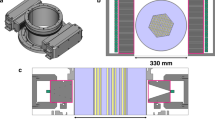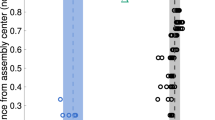Abstract
Dry casks for spent nuclear fuel (SNF) ensure the safe storage of SNF and provide radiation shielding. However, the presence of the thick casks encompassing several layers of steel and concrete makes inspection of the SNF a challenging task. Fast neutron interrogation is a viable method for the nondestructive assay of dry storage casks. In this study, we performed a Monte Carlo simulation-based study associated with a machine-learning-based image reconstruction method to verify the content of SNF dry storage casks. We studied the use of neutron transmission and back-scattered measurements to assess the potential damage to fuel assemblies or fuel pin diversion during transportation of dry casks. We used Geant4 to model a realistic HI-STAR 100 cask, MPC-68 canister and basket, and GE-14 fuel assembly irradiated by a D-T neutron generator. Several bundle diversion scenarios were simulated. The angular distribution of the neutrons scattered by the cask was used to identify the diversions inside the fuel cask. A fuel bundle with at least 75% of its pins removed can be identified with a drop in the back-scattered signature larger than \(2\sigma\) compared with a fully loaded scenario. We combined an iterative reconstruction algorithm with a convolutional neural network (CNN) to obtain a cross-sectional image of the fuel inside the cask. The proposed imaging approach allows locating the position of a missing fuel bundle with at least 75% of the pins removed when performing tomographic imaging of a canister with an overall scan time of less than two hours, when using a commercial neutron generator with a source strength of \(10^{10}\) n/s in the 4\(\pi\) solid angle.














Similar content being viewed by others
References
Storage of Spent Nuclear Fuel, No. SSG-15 in Specific Safety Guides. International Atomic Energy Agency, Vienna, 2012. https://www.iaea.org/publications/8532/storage-of-spent-nuclear-fuel. [Online; accessed 27-February-2018].
Greulich, C., Hughes, C., Gao, Y., Enqvist, A., & Baciak, J. (2017). High energy neutron transmission analysis of dry cask storage. Nuclear Instruments and Methods in Physics Research Section A: Accelerators, Spectrometers, Detectors and Associated Equipment, 874, 5–11.
Transportation of spent nuclear fuel. (2020). https://www.nrc.gov/waste/spent-fuel-transp.html. [Online; accessed 27-February-2018].
Blair, D. S. (2014). A global perspective on continuity of knowledge: Concepts and challenges. Tech. rep., Sandia National Lab. (SNL-NM), Albuquerque, NM (United States)
Wharton, C., Seabury, E., Caffrey, A., & Winston, P. (2013). Summary report: INL CDCIS cask scanner testing at Doel, Belgium. Idaho National Laboratory: Tech. Rep.
Poulson, D., Durham, J. M., Guardincerri, E., Morris, C., Bacon, J. D., Plaud-Ramos, K., Morley, D., & Hecht, A. A. (2017). Cosmic ray muon computed tomography of spent nuclear fuel in dry storage casks. Nuclear Instruments and Methods in Physics Research Section A: Accelerators, Spectrometers, Detectors and Associated Equipment, 842, 48–53.
Durham, J. M., Poulson, D., Bacon, J., Chichester, D., Guardincerri, E., Morris, C., Plaud-Ramos, K., Schwendiman, W., Tolman, J., & Winston, P. (2018). Verification of spent nuclear fuel in sealed dry storage casks via measurements of cosmic-ray muon scattering. Physical Review Applied, 9(4), 044013.
Chatzidakis, S., Choi, C., & Tsoukalas, L. (2016). Investigation of imaging spent nuclear fuel dry casks using cosmic ray muons. Transactions, 114(1), 152–155.
Chatzidakis, S. (2017). Classification and imaging of spent nuclear fuel dry casks using cosmic ray muons. Oak Ridge, TN: Oak Ridge National Laboratory (ORNL). [Google Scholar].
Miller, C. A., Geddes, C. G., Ludewigt, B. A., Clarke, S. D., & Pozzi, S. A. (2020). Verification of dry storage cask loading using monoenergetic photon sources. Annals of Nuclear Energy, 137, 107091.
Liu, X., & Lee, H. K. (2016). A simulation study of the spent nuclear fuel cask condition evaluation using high energy x-ray computed tomography. NDT & E International, 80, 58–64.
Agostinelli, S., Allison, J., Amako, K. A., Apostolakis, J., Araujo, H., Arce, P., Asai, M., Axen, D., Banerjee, S., Barrand, G. et al. (2003). Geant4–a simulation toolkit. Nuclear Instruments and Methods in Physics Research Section A: Accelerators, Spectrometers, Detectors and Associated Equipment, 506(3), 250–303.
Ezvan, O., Zeng, X., Gencturk, B., & Ghanem, R. Simplified design: HI-STAR 100 cask, MPC-68 canister and basket, GE-14 fuel assembly. Tech. Rep. DE-FOA-0001281, University of Southern California (USC).
Liu, Z., George, J., & Meng, L. J. (2018). Nondestructive assessment of transportation fuel cask using time-tagged neutron interrogations. In Symposium on Radiation Measurements and Applications (SORMA II.
Wikipedia contributors. (2020). Fusion power — Wikipedia, the free encyclopedia. https://en.wikipedia.org/w/index.php?title=Fusion_power&oldid=972723724. [Online; accessed 17-August-2020].
Fang, M., Altmann, Y., Della Latta, D., Salvatori, M., & Di Fulvio, A. (2021). Quantitative imaging and automated fuel pin identification for passive gamma emission tomography. Scientific reports, 11(1), 1–11.
Beck, A., & Teboulle, M. (2009). A fast iterative shrinkage-thresholding algorithm for linear inverse problems. SIAM Journal on Imaging Sciences, 2(1), 183–202.
Korovin, Y. A., & Maksimushkina, A. (2015). The use of neural networks for approximation of nuclear data. Physics of Atomic Nuclei, 78(12), 1406–1414.
Fu, C., Di Fulvio, A., Clarke, S., Wentzloff, D., Pozzi, S., & Kim, H. (2018). Artificial neural network algorithms for pulse shape discrimination and recovery of piled-up pulses in organic scintillators. Annals of Nuclear Energy, 120, 410–421.
Funding
This work is funded in part by the Department of Energy (DOE) under contract number 000128931. The Argonne Leadership Computing Facility (ALCF) provided the access to super-computing resources.
Author information
Authors and Affiliations
Corresponding author
Additional information
Publisher’s Note
Springer Nature remains neutral with regard to jurisdictional claims in published maps and institutional affiliations.
Rights and permissions
About this article
Cite this article
Liu, Z., Fang, M., George, J. et al. Neutron Tomography of Spent Fuel Casks. J Sign Process Syst 94, 399–409 (2022). https://doi.org/10.1007/s11265-021-01706-7
Received:
Revised:
Accepted:
Published:
Issue Date:
DOI: https://doi.org/10.1007/s11265-021-01706-7




